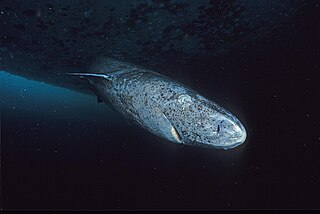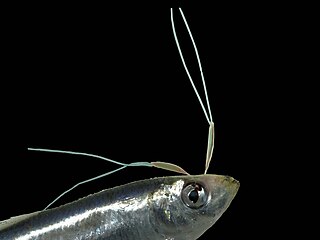Related Research Articles

Copepods are a group of small crustaceans found in nearly every freshwater and saltwater habitat. Some species are planktonic, some are benthic, a number of species have parasitic phases, and some continental species may live in limnoterrestrial habitats and other wet terrestrial places, such as swamps, under leaf fall in wet forests, bogs, springs, ephemeral ponds, and puddles, damp moss, or water-filled recesses (phytotelmata) of plants such as bromeliads and pitcher plants. Many live underground in marine and freshwater caves, sinkholes, or stream beds. Copepods are sometimes used as biodiversity indicators.

Carlos Justiniano Ribeiro Chagas, or Carlos Chagas, was a Brazilian sanitary physician, scientist, and bacteriologist who worked as a clinician and researcher. He discovered Chagas disease, also called American trypanosomiasis, in 1909, while he was working at the Oswaldo Cruz Institute in Rio de Janeiro.

Monstrilloida is an order of copepods with a cosmopolitan distribution in the world's oceans. The order contains a single family, Monstrillidae. The name of the first ever described genus Monstrilla is derived from latin, meaning "tiny monster", because the lack of usual diagnostic features of copepods puzzled early taxonomists.
Bomolochidae is a family of copepods parasitic on marine fishes. Most species parasitize the gills of fish, but some species live in the nostrils or on the eyes of their hosts. The family contains just over 150 species from the following genera:
Acantholochus is a genus of parasitic copepods belonging to the family Bomolochidae. Its members can only be distinguished from the closely related genus Hamaticolax by the absence of an accessory process on the claw of the maxillipeds.
Hematodinium is a genus of dinoflagellates. Species in this genus, such as Hematodinium perezi, the type species, are internal parasites of the hemolymph of crustaceans such as the Atlantic blue crab and Norway lobster. Species in the genus are economically damaging to commercial crab fisheries, including causing bitter crab disease in the large Tanner or snow crab fisheries of the Bering Sea.

Ommatokoita elongata is a 30 mm (1.2 in) long pinkish-white parasitic copepod, frequently found permanently attached to the corneas of the Greenland shark and Pacific sleeper shark. The parasites cause severe visual impairment, but it is thought that the sharks do not rely on keen eyesight for their survival. It was speculated that the copepod may be bioluminescent and thus form a mutualistic relationship with the shark by attracting prey, but this hypothesis has not been verified. It is the only species in the genus Ommatokoita, although a specimen has been found on the skin of Etmopterus princeps assigned to the genus but not species.

Hassalstrongylus is a genus of nematode worms that infect mostly muroid rodents from eastern North America to South America. The genus is part of the Heligmonellidae and related to genera like Stilestrongylus.

Pennellidae is a family of parasitic copepods. When anchored on a host, they have a portion of the body on the outside of the host, whereas the remaining anterior part of the parasite is hidden inside tissues of the host.

Lernaeocera branchialis, sometimes called cod worm, is a parasite of marine fish, found mainly in the North Atlantic. It is a marine copepod which starts life as a small pelagic crustacean larva. It is among the largest of copepods, ranging in size from 2 to 3 millimetres when it matures as a copepodid larva to more than 40 mm as a sessile adult.
Hamaticolax is a genus of parasitic copepods belonging to the family Bomolochidae. Its members can only be distinguished from the closely related genus Acantholochus by the presence of an accessory process on the claw of the maxillipeds. It includes the following species:
Pennella is a genus of large copepods which are common parasites of large pelagic fishes. They begin their life cycle as a series of free-swimming planktonic larvae. The females metamorphose into a parasitic stage when they attach to a host and enter into its skin. The males are free swimming. Due to their large size and mesoparasitic life history there have been a number of studies of Pennella, the members of which are among the largest of the parasitic Copepoda. All species are found as adults buried into the flesh of marine bony fish, except for a single species, Pennella balaenopterae which can be found in the muscles and blubber of cetaceans and occasionally other marine mammals, and is the largest species of copepod.

Lepeophtheirus pectoralis is a species of parasitic copepod from the northeast Atlantic Ocean, and the type species of the genus Lepeophtheirus. It is a parasite of flatfish, with the European flounder, the plaice, and the dab as the most frequent hosts. It feeds on the mucus, skin, and blood of the fish, with egg-producing females infecting the pectoral and pelvic fins of the host, while immature individuals and males are found on the rest of the body.
Archidactylina is a genus of copepods that contains only the species Archidactylina myxinicola, and is the only genus in the family Archidactylinidae. It is a parasite of the gill pouches of two species of hagfish found in Japanese waters, Eptatretus okinoseanus and Myxine garmani.
Peniculisa is a genus of marine parasitic copepods in the family Pennellidae.
Cardiodectes is a genus of copepods in the family Pennellidae. Species are parasites of fish.

František Moravec is a Czech parasitologist who specialised on the Nematodes, especially the nematodes parasites of fishes. His research was mainly in the field of taxonomy of the Nematoda.

Jean-Lou Justine, French parasitologist and zoologist, is a professor at the National Museum of Natural History in Paris, France, and a specialist of fish parasites and invasive land planarians.

Microcotyle pomatomi is a species of monogenean that is parasitic on the gills of a marine fish. It belongs to the family Microcotylidae.
References
- 1 2 Luiz E. R. Tavares & José L. Luque (2003). "A New Species of Acantholochus (Copepoda: Bomolochidae) Parasitic on Centropomus undecimalis (Osteichthyes: Centropomidae) from the Coastal Zone of the State of Rio de Janeiro, Brazil" (PDF). Memórias do Instituto Oswaldo Cruz . 98: 241–245.
- ↑ Ju-shey Ho (2010). T. Chad Walter & Geoff Boxshall (ed.). "Hamaticolax unisagittatus (Tavares & Luque, 2003)". World Copepoda database. World Register of Marine Species . Retrieved October 28, 2010.